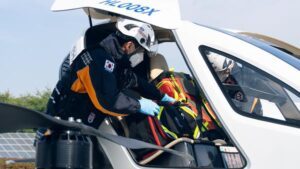
A recent report by the Aerospace Industries Association (AIA) and global consulting firm Deloitte predicts that the US advanced air mobility market could reach $115B by 2035 and create 280,000 jobs – if it’s handled right.
“Advanced Air Mobility: Can the U.S. Afford to Lose the Race?” says that the new industry is “predicted to become mainstream in the 2030’s” and that “U.S. aerospace and defense (A&D) companies are poised to lead the nascent global industry.”
Advanced air mobility, the next disruption in aerospace
Passenger drones, air taxis, cargo drones and more make up the Advanced Air Mobility (AAM) market. In the last year, AAM companies have received major investment and have seen tremendous growth in trial projects that range from aerial sightseeing to high-rise apartment building firefighting. The benefits of AAM as part of efforts to adopt more environmentally friendly transportation and relieve road congestion are very clear. To date, however, the vast majority of trial projects have taken place outside of the U.S.
“Our industry is on the cusp of the next great step in aviation technology,” said Eric Fanning, AIA president and CEO. “By establishing a national strategy in AAM, we have the potential to give the U.S. a major competitive advantage in the global market and realize new national security benefits, including new ways to transport our troops and cargo. U.S. leadership in this emerging aviation technology is essential to bolstering our economy and innovation within America.”
It’s a high stakes race, but “the global race for AAM leadership is intensifying, and the U.S. faces strong competition from China, Germany and South Korea,” says Deloitte. In order to compete, the U.S. will need to accommodate AAM trials and begin work to develop appropriate infrastructure and regulations – soon.
“The deployment of AAM will require a sustained, collaborative approach between the private and public sectors to push for eVTOL aircraft to be widely accepted and adopted, sooner rather than later,” said Robin Lineberger, Deloitte Global and U.S. A&D leader. “With the market poised to grow sevenfold between 2025 and 2035, it’s important for U.S. policymakers and industries to cooperate now to ensure American leadership in this transformative emerging sector.”

Miriam McNabb is the Editor-in-Chief of DRONELIFE and CEO of JobForDrones, a professional drone services marketplace, and a fascinated observer of the emerging drone industry and the regulatory environment for drones. Miriam has penned over 3,000 articles focused on the commercial drone space and is an international speaker and recognized figure in the industry. Miriam has a degree from the University of Chicago and over 20 years of experience in high tech sales and marketing for new technologies.
For drone industry consulting or writing, Email Miriam.
TWITTER:@spaldingbarker
Subscribe to DroneLife here.







[…] a major increase in the connectivity of the Emirate’s health ecosystem and position it as a global leader in advanced air mobility. The DoH shared news of the project […]